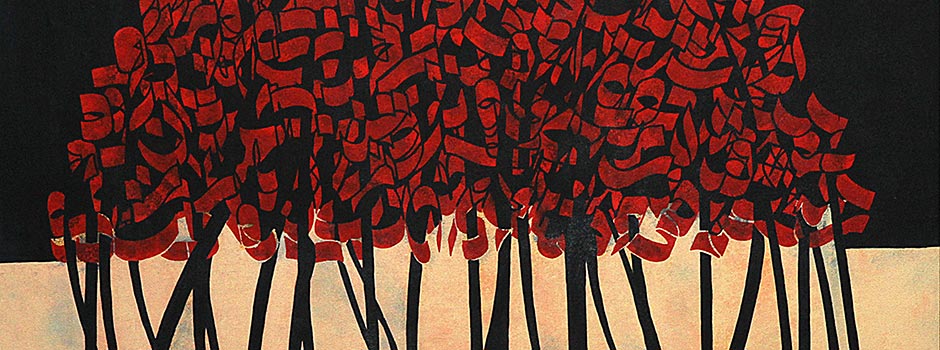
Islamic Arts Museum Malaysia, Kuala Lumpur (21 Jan - 31 May 2020) An Introduction to Islamic Calligraphy
Feb 06, 2020 FEATURE, Art Collection

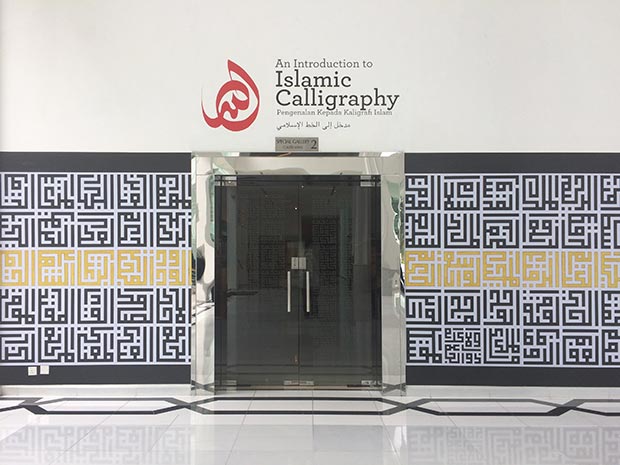 Exhibition Entrance / Courtesy of IAMM
Exhibition Entrance / Courtesy of IAMM
An Introduction to Islamic Calligraphy examines one of the most important historical developments of the Islamic world. Covering more than a thousand years, it encompasses a vast geographical area: from the Iberian Peninsula, in the west, to Southeast Asia and China in the east. Calligraphy plays a vital role in the design of both religious and everyday arts and crafts, as well as in developing a distinctive visual culture inspired by Islam. Major calligraphy styles such as Kufic, Naskh, Thuluth, Muhaqqaq, Rayhani, Tawqi, Riqa, Nastaliq, Diwani and Maghribi scripts were developed over the years by prominent calligraphers and were used as ornaments in works of art, glorifying the Word of God.
The exhibition gallery is divided into four sections: Word of God, The Art of Calligraphy, Beauty in Diversity and Contemporary Calligraphy. One of the main objectives of the exhibition is to present the different styles of Islamic calligraphy to visitors, as Islamic calligraphy is one of the essential elements of decorative Islamic art. Among the masterpieces on display is the Sitarah, a curtain which was commissioned by the Ottoman ruler, Sultan Abdul Majid (r. 1839-1861 AD), as a gift for the Prophet's tomb in Medina.
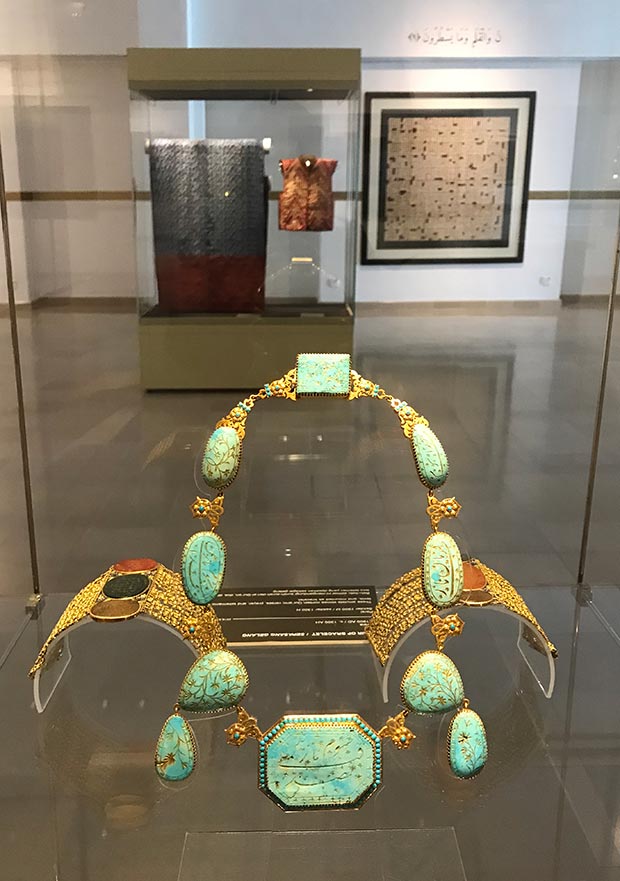 Turquoise and Gold Necklace, Qajar Persia, Early 19th Century AD (early 13th century AH), 2014.13.12. The inscriptions written in Nastaliq's script reads: "May I be your ransom. [May I] be sacrificed for your coquetry. May I be your ransom, O beloved! [May] I be sacrificed for you, O beloved!" / Courtesy of IAMM
Turquoise and Gold Necklace, Qajar Persia, Early 19th Century AD (early 13th century AH), 2014.13.12. The inscriptions written in Nastaliq's script reads: "May I be your ransom. [May I] be sacrificed for your coquetry. May I be your ransom, O beloved! [May] I be sacrificed for you, O beloved!" / Courtesy of IAMM
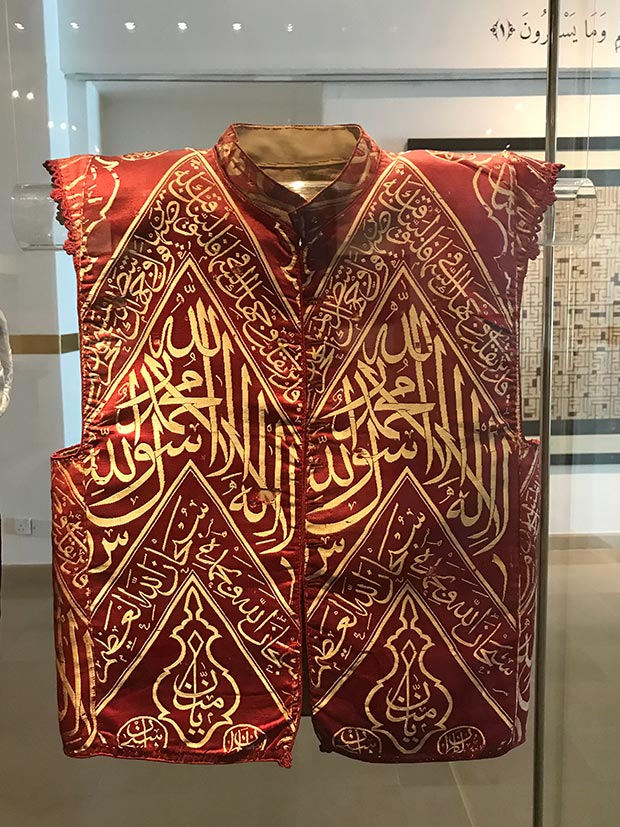 Waistcoat, Malay Peninsula, Late 19th century AD (late 13th century AH), 1998.1.4156. This waistcoat in Malay style is made of the interior lining (kiswa) of Kaaba, the production of the Ottoman period most probably in Bursa. The calligraphic inscription between the zigzag designs and medallion reads: Blessings to Allah and praise be to Him, Blessed be Allah the Great, Oh, Lord who give us riches, There is no God but Allah and Prophet Muhammad is the Messenger, Surah al-Baqarah (2:144), and Oh, Sultan. / Courtesy of IAMM
Waistcoat, Malay Peninsula, Late 19th century AD (late 13th century AH), 1998.1.4156. This waistcoat in Malay style is made of the interior lining (kiswa) of Kaaba, the production of the Ottoman period most probably in Bursa. The calligraphic inscription between the zigzag designs and medallion reads: Blessings to Allah and praise be to Him, Blessed be Allah the Great, Oh, Lord who give us riches, There is no God but Allah and Prophet Muhammad is the Messenger, Surah al-Baqarah (2:144), and Oh, Sultan. / Courtesy of IAMM
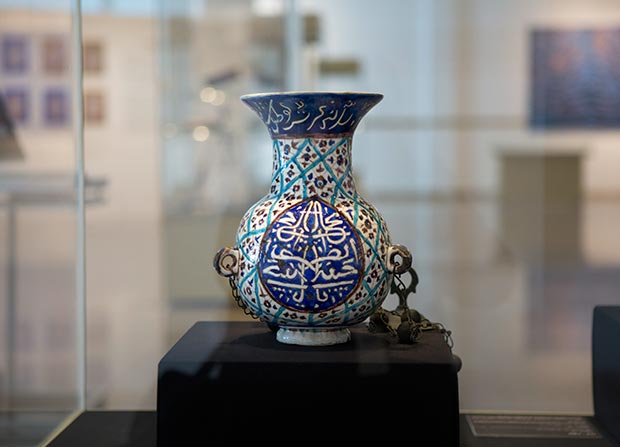 Mosque Lamp, Ottoman Turkey, 19th century AD (13th century AH), 2015.12.39. Calligraphic inscriptions are painted in mirror composition within the drop-shaped medallion and around the flaring mouth of this mosque lamp. / Courtesy of IAMM
Mosque Lamp, Ottoman Turkey, 19th century AD (13th century AH), 2015.12.39. Calligraphic inscriptions are painted in mirror composition within the drop-shaped medallion and around the flaring mouth of this mosque lamp. / Courtesy of IAMM
The Arabic saying goes, "Purity of writing is the purity of the soul" which describes the status of the master calligrapher in Islamic society. It is known that only a person of spiritual devotion could achieve great calligraphic skills. Master calligraphers worked at the royal ateliers as scribes and teachers to the royalties. The foundation of Islamic calligraphy was laid down by three great calligraphers: Ibn Muqla (886-940 AD) of Abbasid courts, Ibn al-Bawwab and Yakut al-Mustasimi (d. 1298 AD). Their great traditions produced more outstanding calligraphers such as al-Nayrizi (1682-1722 AD), a Persian who worked at the royal atelier of Sultan Husayn (r. 1694 - 1722 AD) during the Safavid dynasty. One of his masterpieces, an album consisting of 30 duas (prayers), is on display at the exhibition gallery.
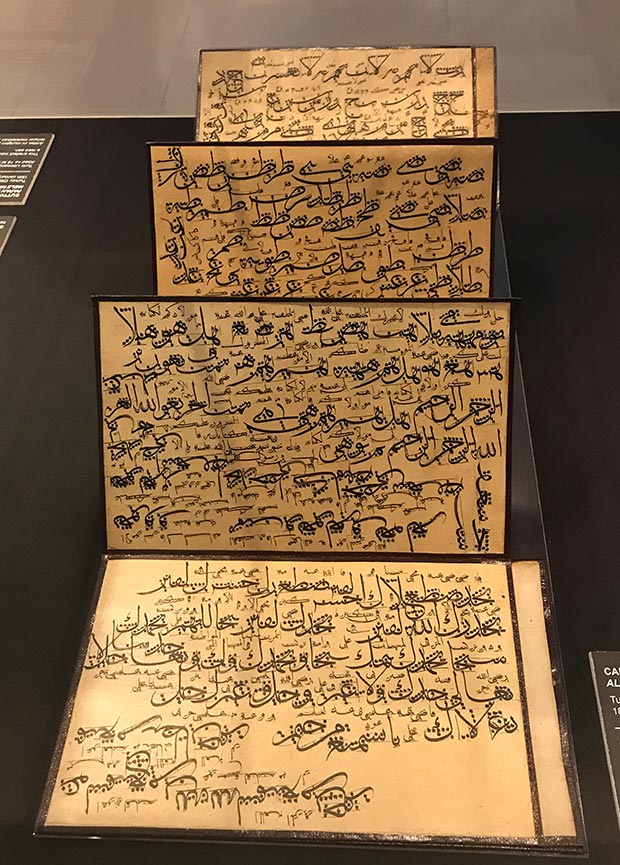 Calligraphic Exercise Album, Turkey, 1868-9 AD (1285 AH). Calligraphic practice sheets bound in concertina format for writing single letters and their composite forms. It is the work of Muhammad Shauqi. / Courtesy of IAMM
Calligraphic Exercise Album, Turkey, 1868-9 AD (1285 AH). Calligraphic practice sheets bound in concertina format for writing single letters and their composite forms. It is the work of Muhammad Shauqi. / Courtesy of IAMM
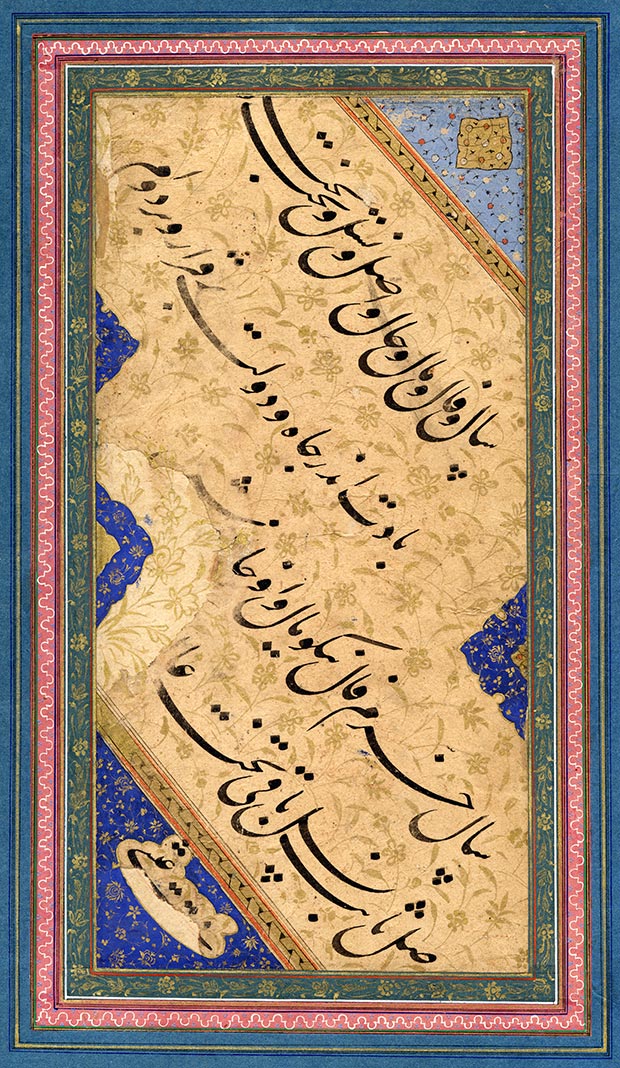 Calligraphic Folio, Persia, c. 1543-1573 AD (c. 950-980 AH). This folio is penned in Nastaliq script and signed by the calligrapher Eyshi, who worked in the royal library of Ibrahim Mirza, a Safavid prince. / Courtesy of IAMM
Calligraphic Folio, Persia, c. 1543-1573 AD (c. 950-980 AH). This folio is penned in Nastaliq script and signed by the calligrapher Eyshi, who worked in the royal library of Ibrahim Mirza, a Safavid prince. / Courtesy of IAMM
Contemporary artworks by a renowned Chinese Muslim calligrapher, Haji Noor Deen Mi Guang Jiang, and Malaysian calligrapher, Allahyarham Haji Omar Rahmat, are also on display. Both artworks approach Islamic calligraphy through the adaptation of different methods and media. Haji Noor Deen uses the traditional Chinese technique in producing his artwork. Instead of a pen, he uses brushes. Hence, the result is different from other traditional calligraphy artworks. Another interesting contemporary artwork is a calligraphic sculpture by Jordanian artist, Nassar Mansour, entitled HUWA II. The contemporary calligraphers explore new realms of writing and bring the light of inspiration and imagination to the paramount visual expression of Islamic culture.
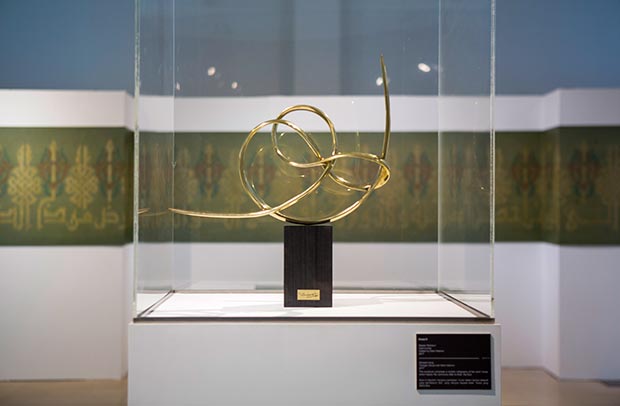 Nassar Mansour, Huwa II, Cast bronze. Casted by Malin Malinov, 2017. This sculpture composes a stylistic calligraphy of the word huwe, commonly referring to Allah, the God. / Courtesy of IAMM
Nassar Mansour, Huwa II, Cast bronze. Casted by Malin Malinov, 2017. This sculpture composes a stylistic calligraphy of the word huwe, commonly referring to Allah, the God. / Courtesy of IAMM
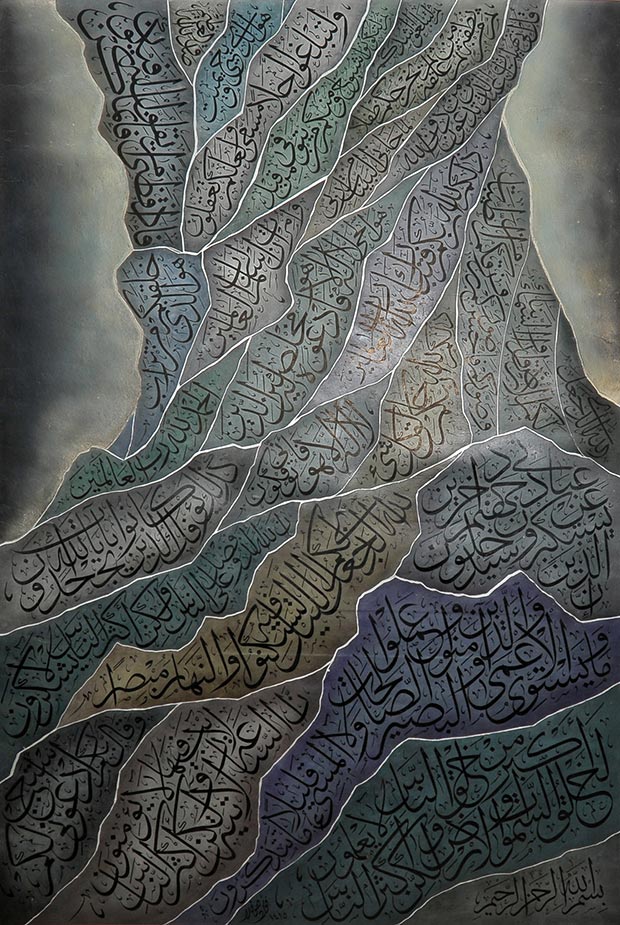 Fuad Kouichi Honda (b. 1946, Japan), Surah Ghafir; v.57-68, Mixed media on paper, 2004 / Courtesy of IAMM
Fuad Kouichi Honda (b. 1946, Japan), Surah Ghafir; v.57-68, Mixed media on paper, 2004 / Courtesy of IAMM
The exhibition comes with a publication entitled Introduction to Islamic Arts - Calligraphy: The Collection of the Islamic Arts Museum Malaysia. The catalogue presents the four sections in the exhibition gallery, featuring the most important historical developments, artistic trends, as well as selected masterpieces produced within the Islamic world. The collection takes us to the 20th century and presents calligraphy in the contemporary and modern world..
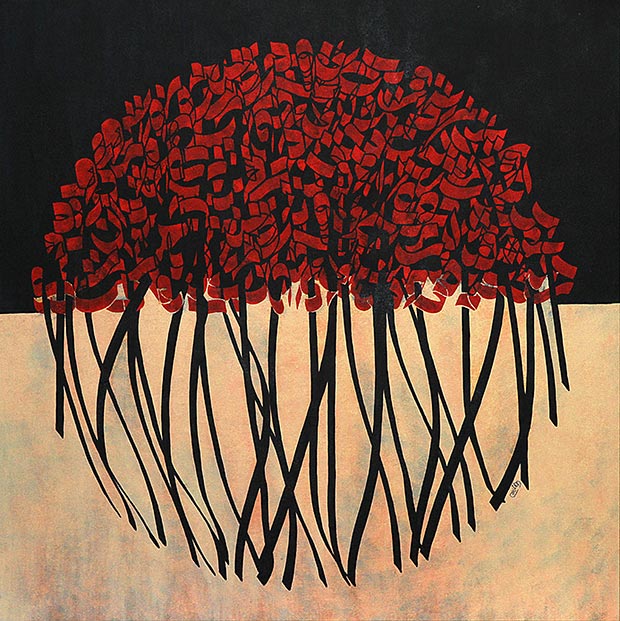 Maryam Ghanbarian (b. 1987, Iran), Untitled, Acrylic on canvas, 2012 / Courtesy of IAMM
Maryam Ghanbarian (b. 1987, Iran), Untitled, Acrylic on canvas, 2012 / Courtesy of IAMM
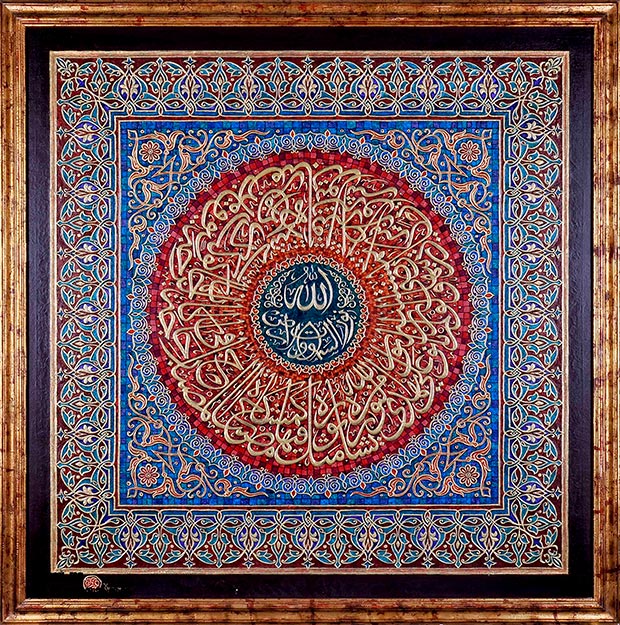 Haji Omar Rahmat (b. 1942, Malaysia), Surah Al-Nur 35, Mixed media on canvas, 1994 / Courtesy of IAMM
Haji Omar Rahmat (b. 1942, Malaysia), Surah Al-Nur 35, Mixed media on canvas, 1994 / Courtesy of IAMM
The IAMM Education Department has also lined up a variety of programmes for the public such as lectures, competitions, and hands-on workshops, throughout the four months of the exhibition. One of the highlights is the most sought-after competition, the 7th Manifestasi Perdana Seni Khat, on 4 April 2020. For the first time, IAMM will introduce a category known as Digital Calligraphy in Kufic script style in the competition, apart from the Spontaneous category.
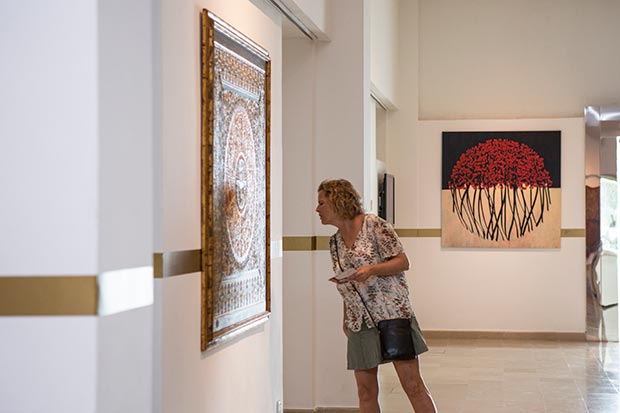 Exhibition An Introduction to Islamic Calligraphy / Courtesy of IAMM
Exhibition An Introduction to Islamic Calligraphy / Courtesy of IAMM
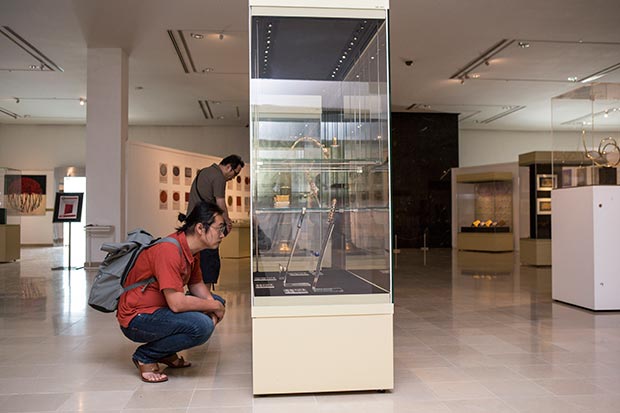 Exhibition An Introduction to Islamic Calligraphy / Courtesy of IAMM
Exhibition An Introduction to Islamic Calligraphy / Courtesy of IAMM
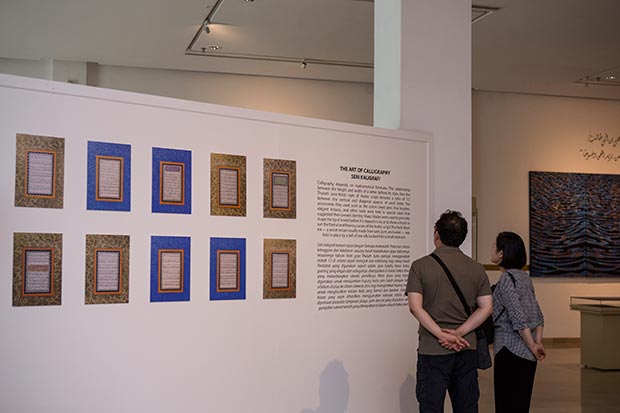 Exhibition An Introduction to Islamic Calligraphy / Courtesy of IAMM
Exhibition An Introduction to Islamic Calligraphy / Courtesy of IAMM
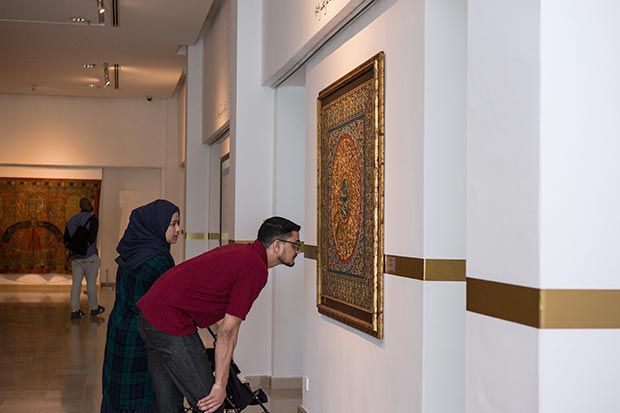 Exhibition An Introduction to Islamic Calligraphy / Courtesy of IAMM
Exhibition An Introduction to Islamic Calligraphy / Courtesy of IAMM
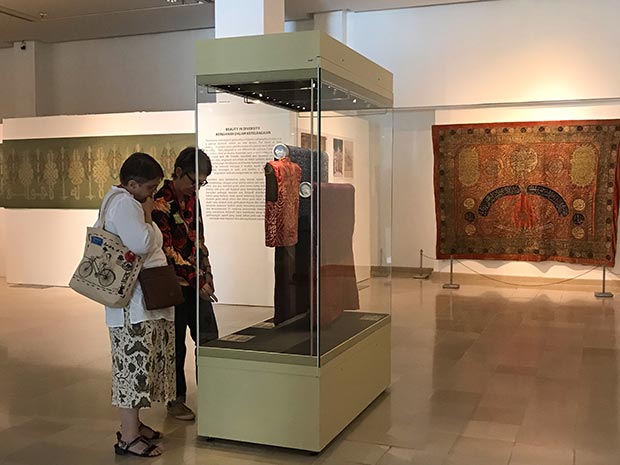 Exhibition An Introduction to Islamic Calligraphy / Courtesy of IAMM
Exhibition An Introduction to Islamic Calligraphy / Courtesy of IAMM
In conjunction with the exhibition, a renowned Jordanian artist, Nassar Mansour, will be giving a lecture and calligraphy demonstration. Besides the competition, IAMM will also organise two workshops in conjunction with the exhibition: Maghribi Calligraphy Workshop (16 February 2020) and the Digital Calligraphy for Commercial workshop (8 March 2020).
Comments
Add a comment